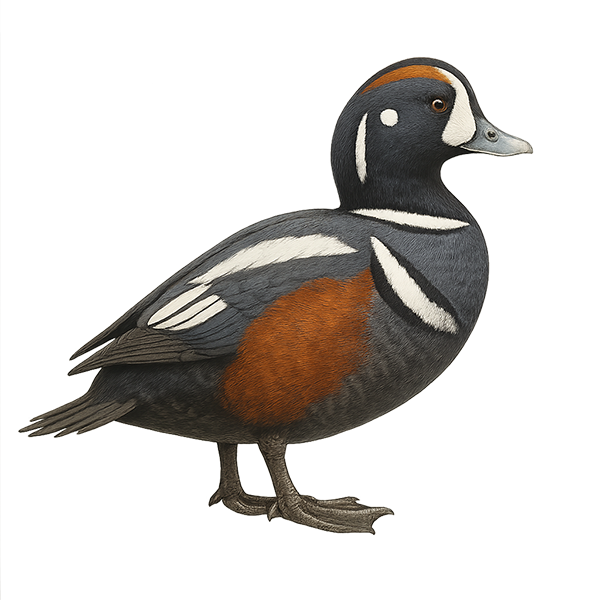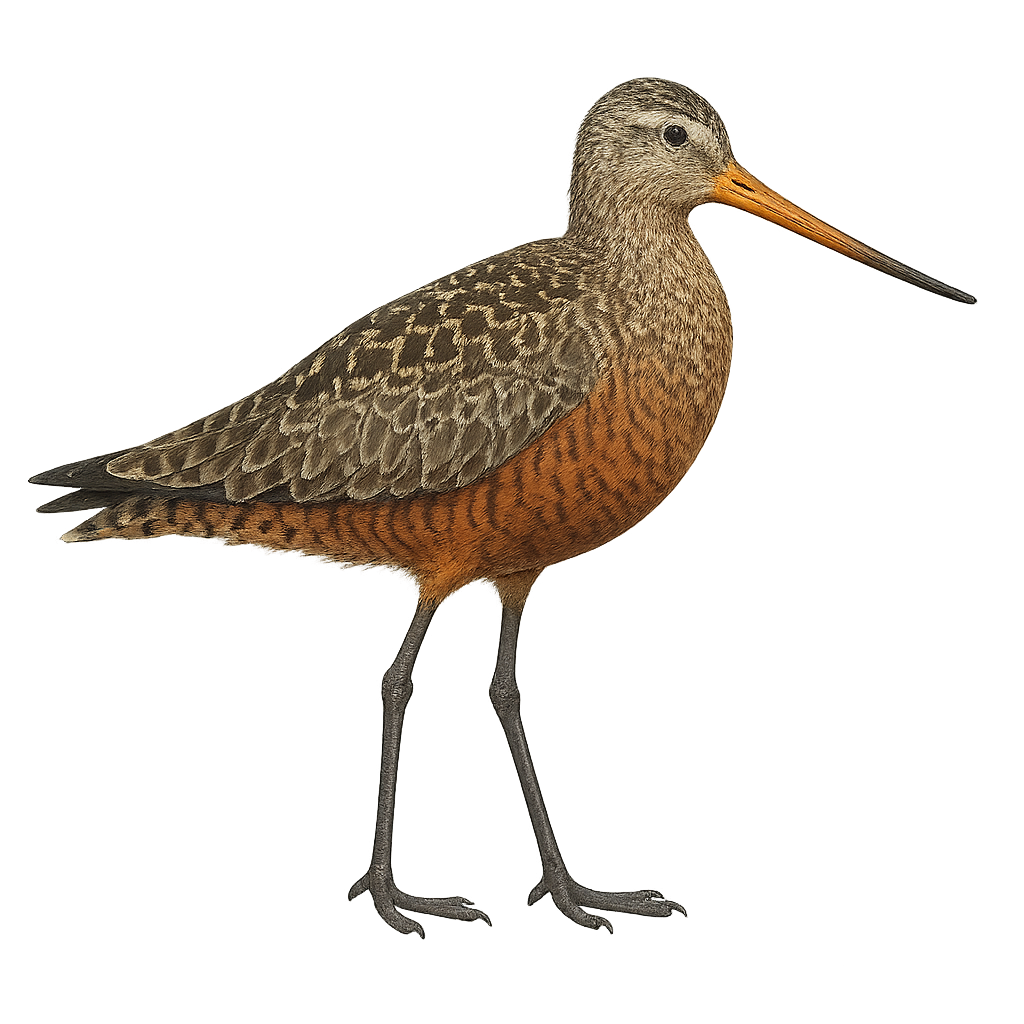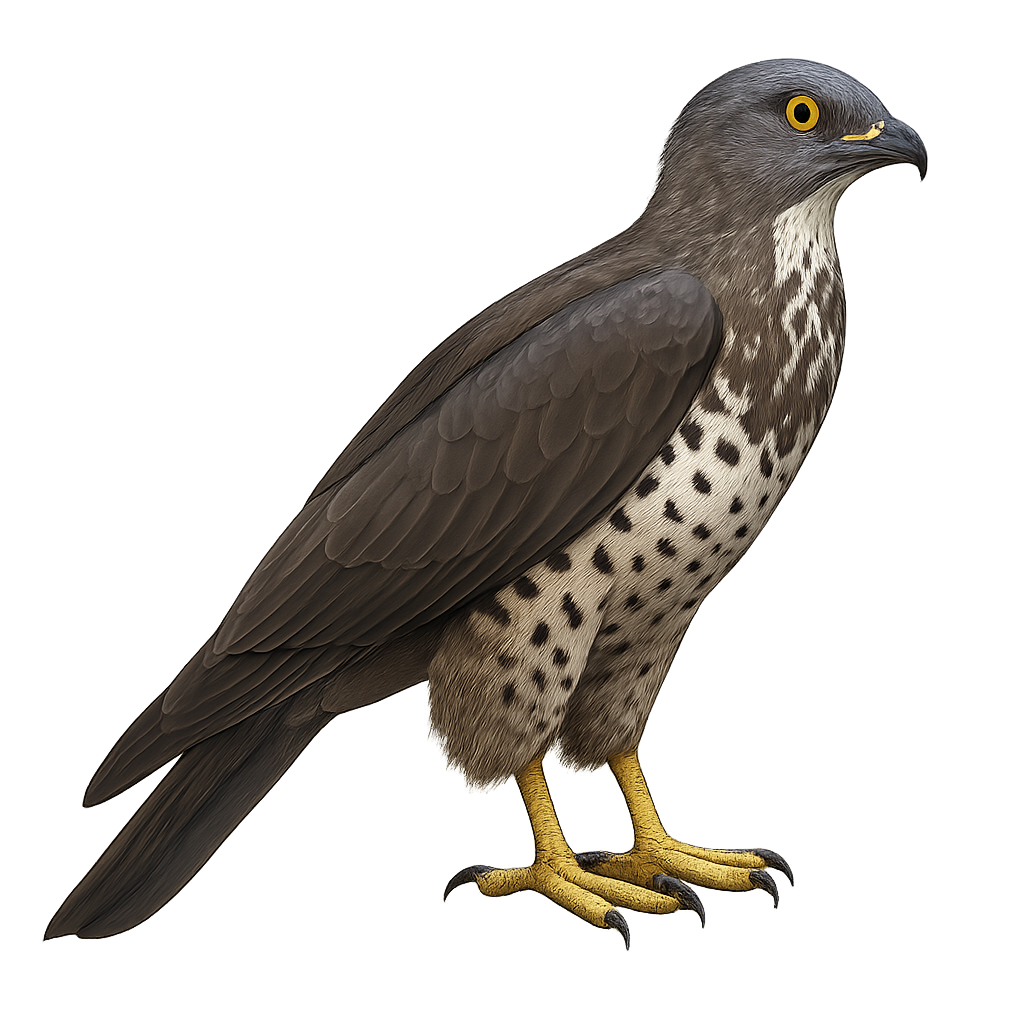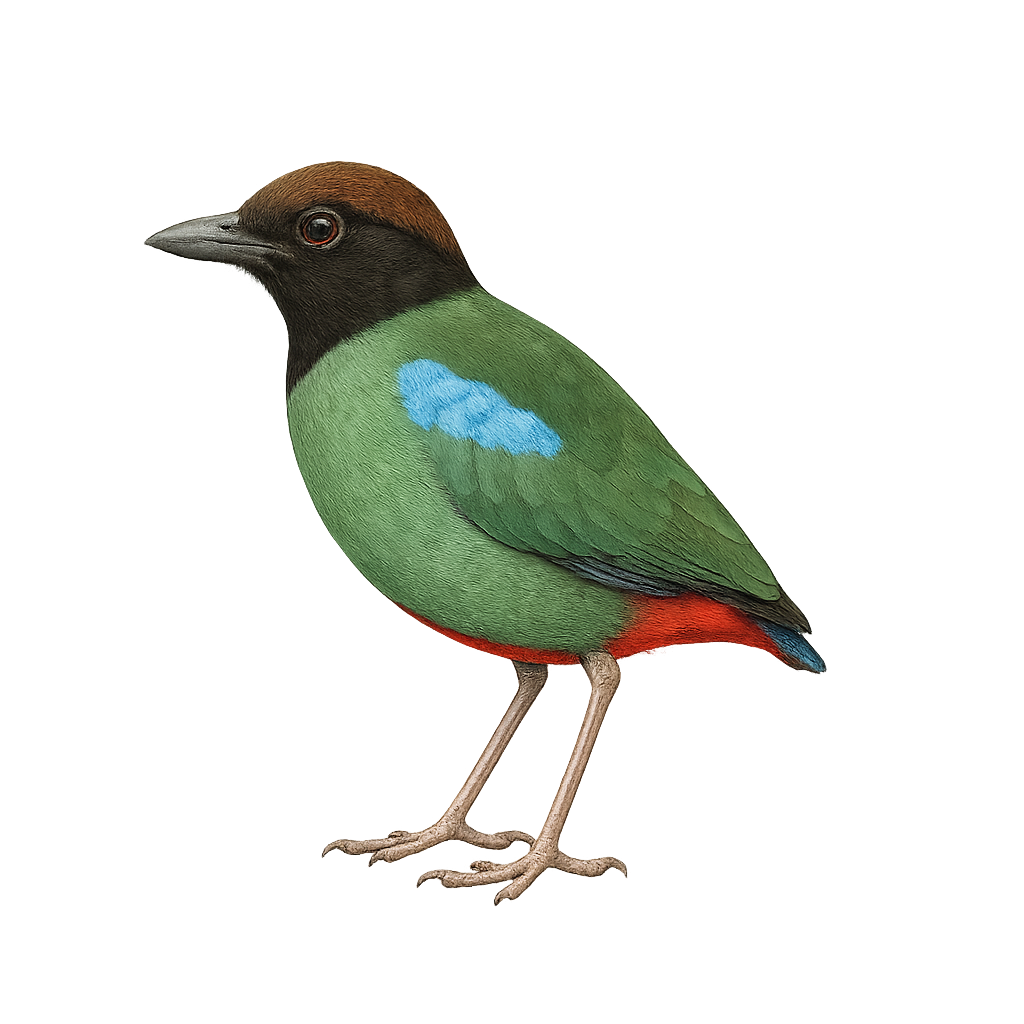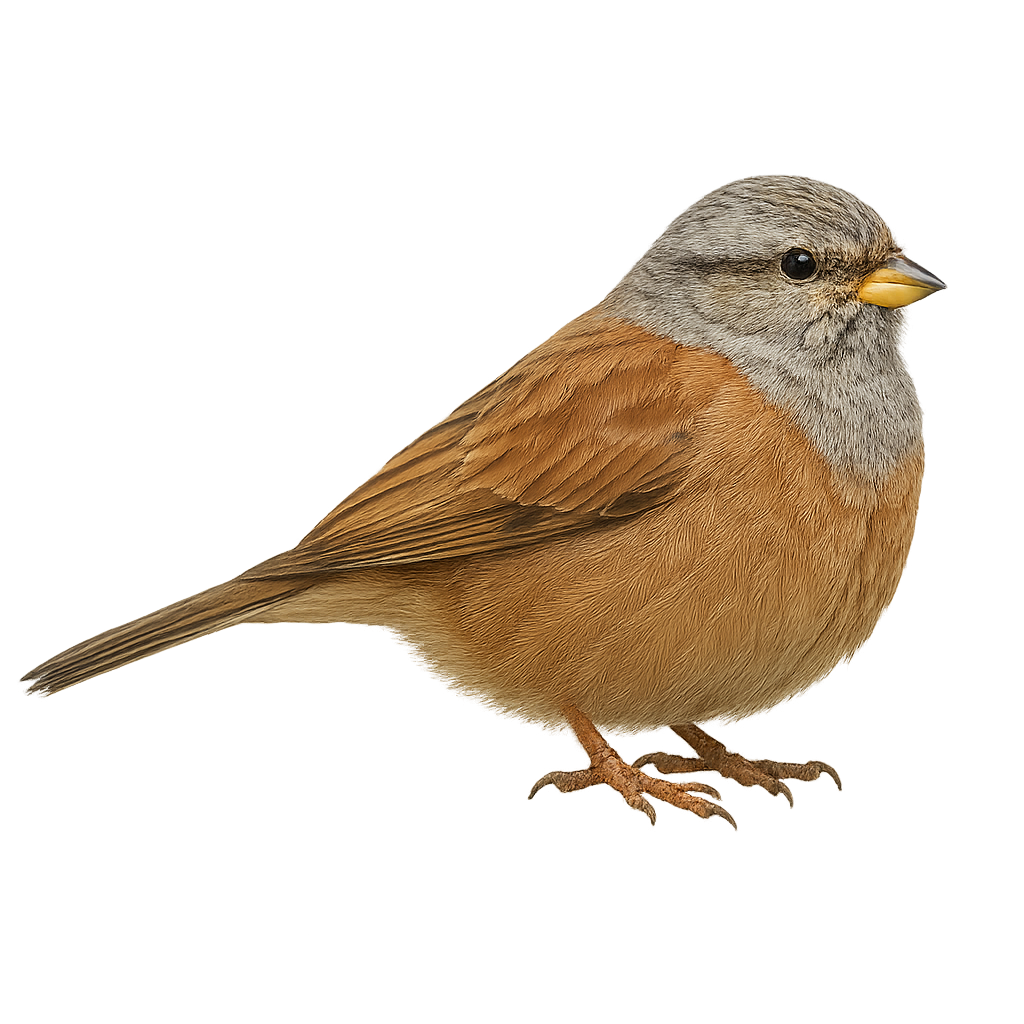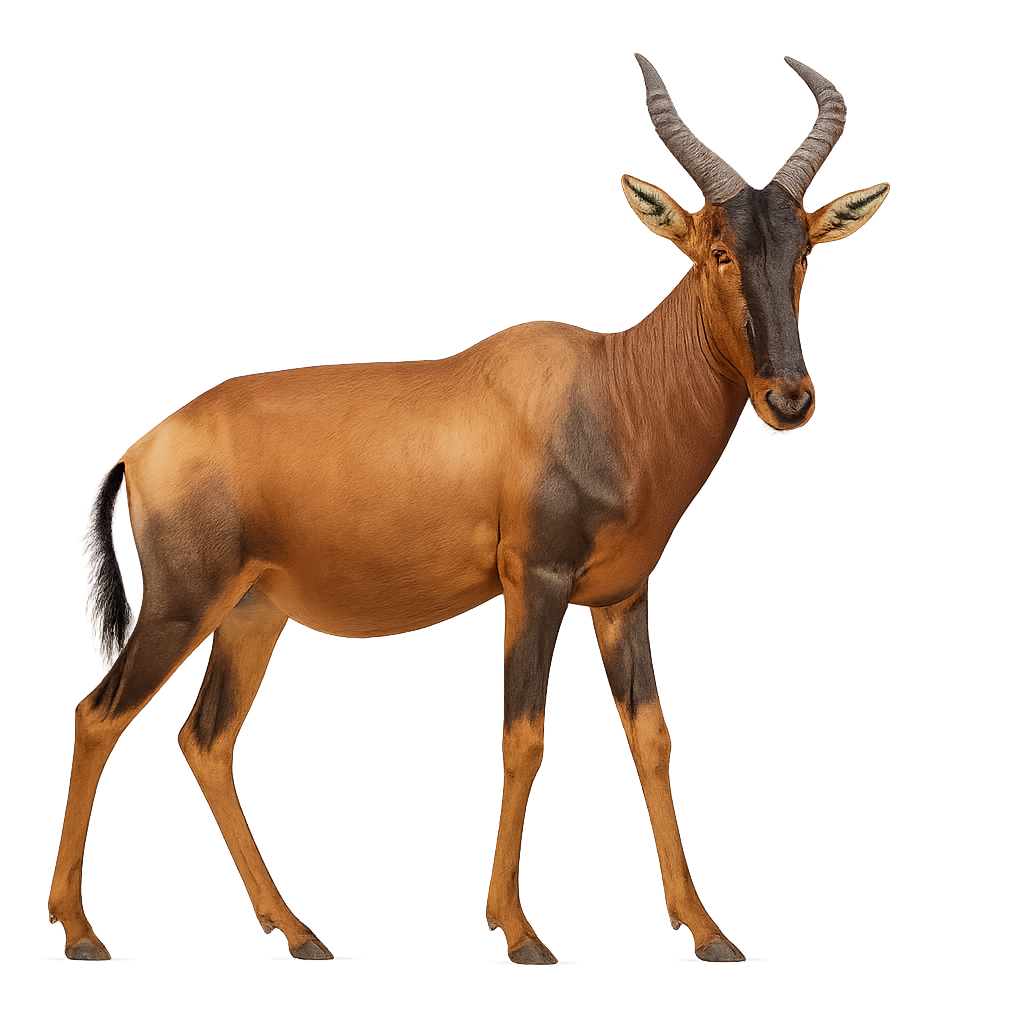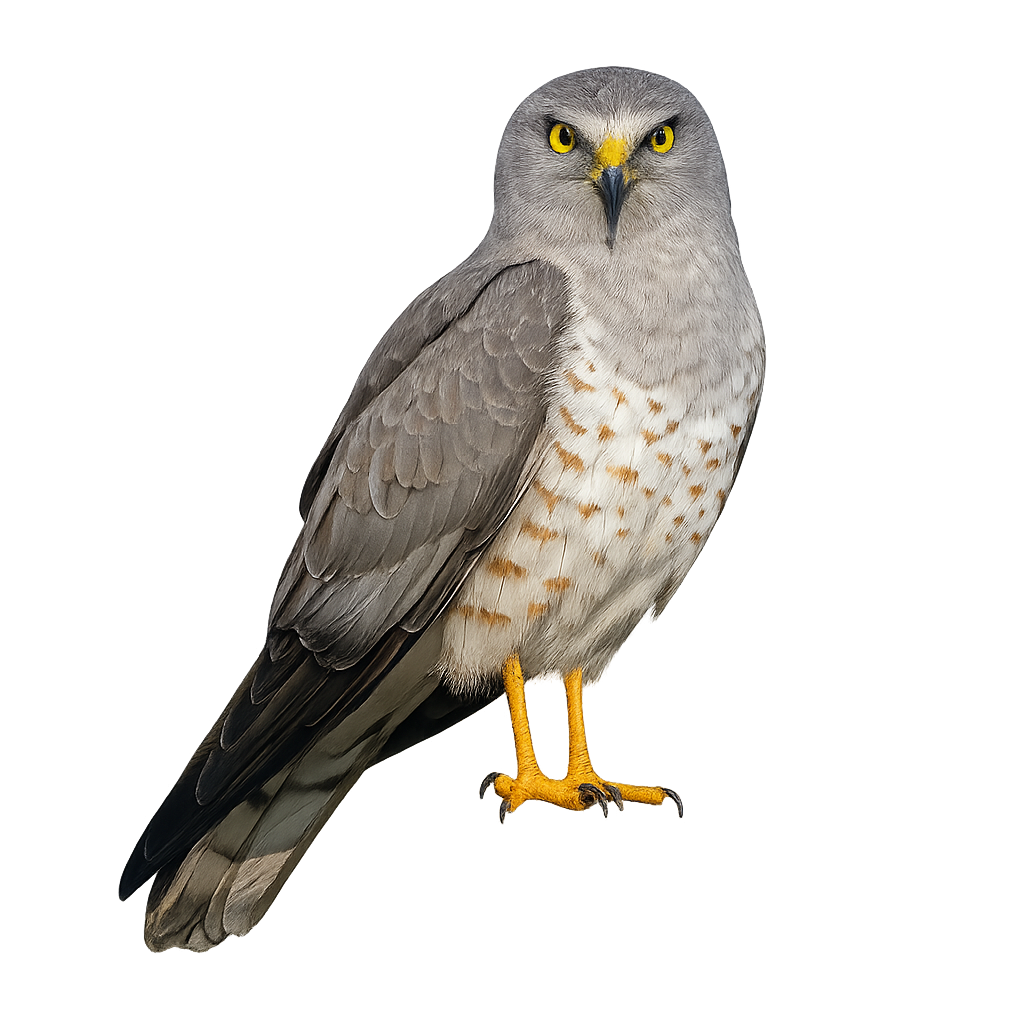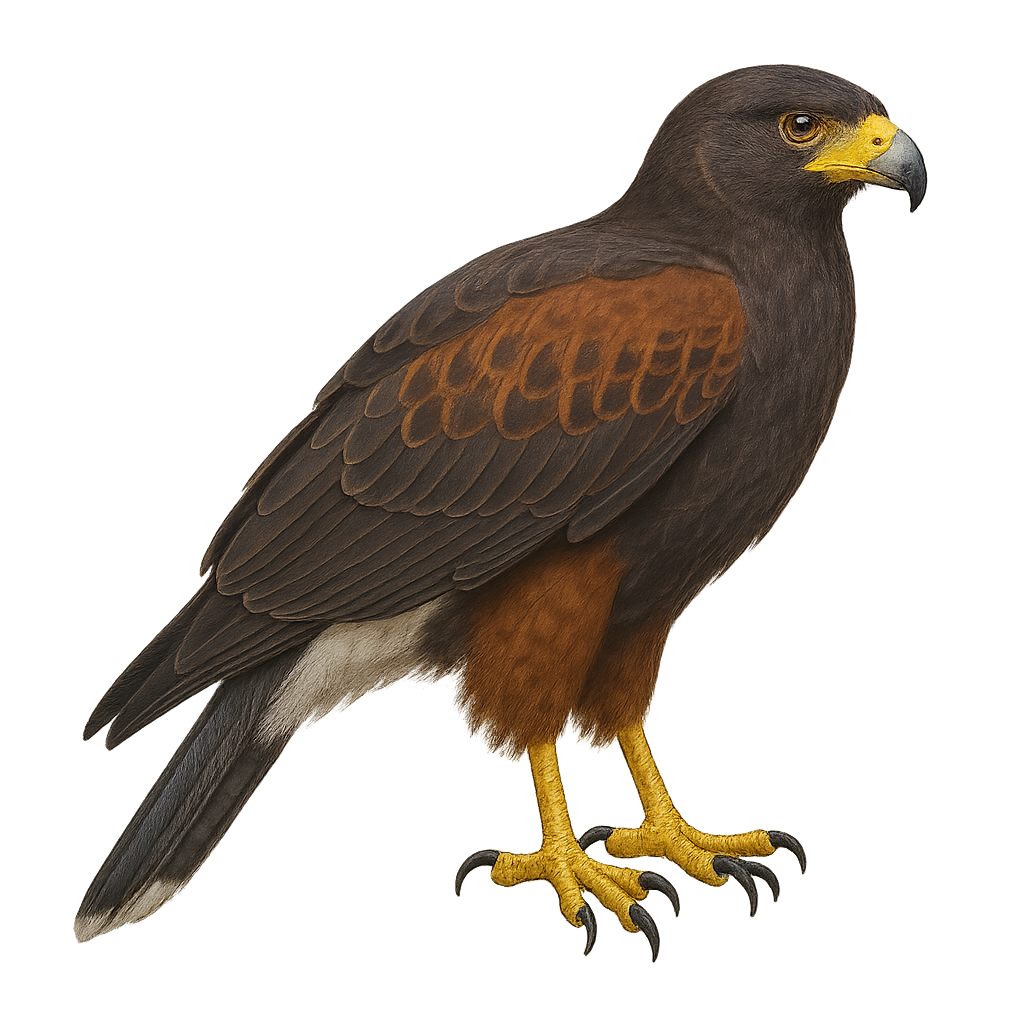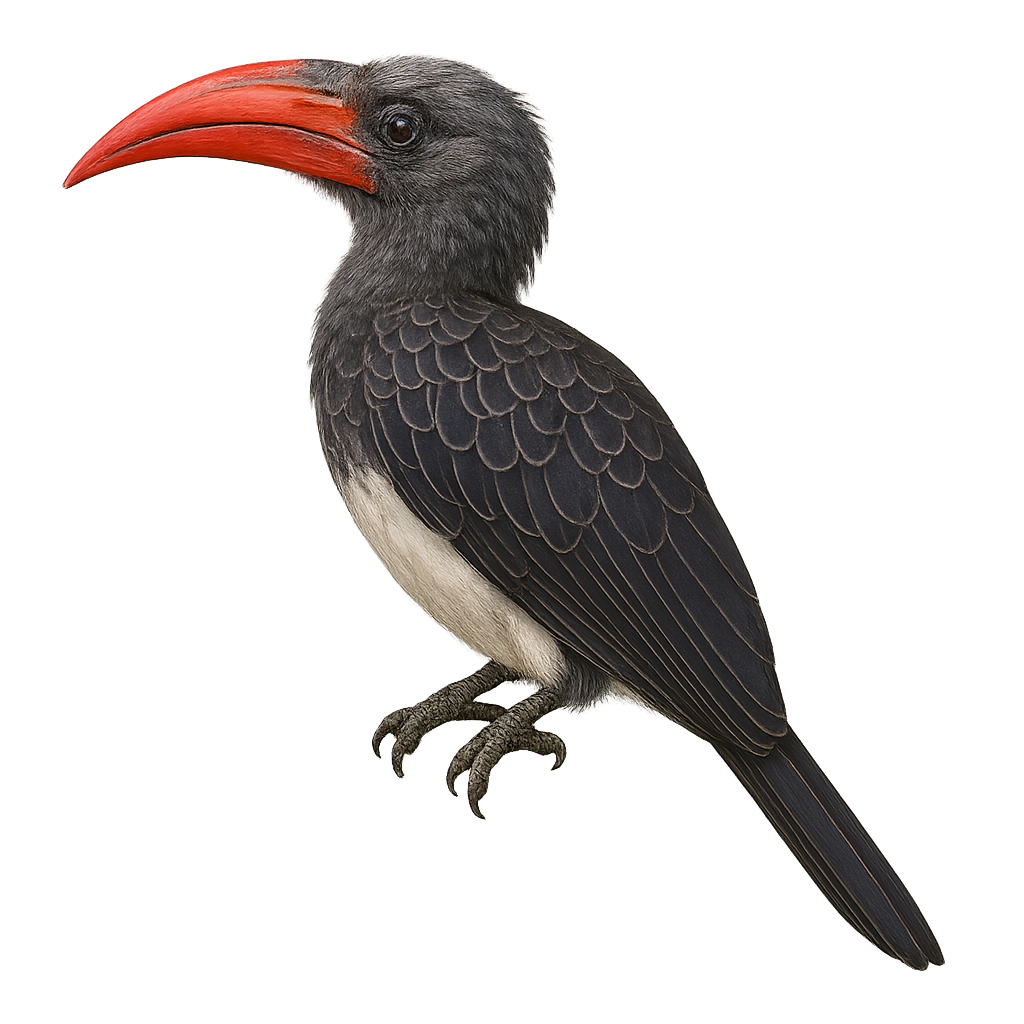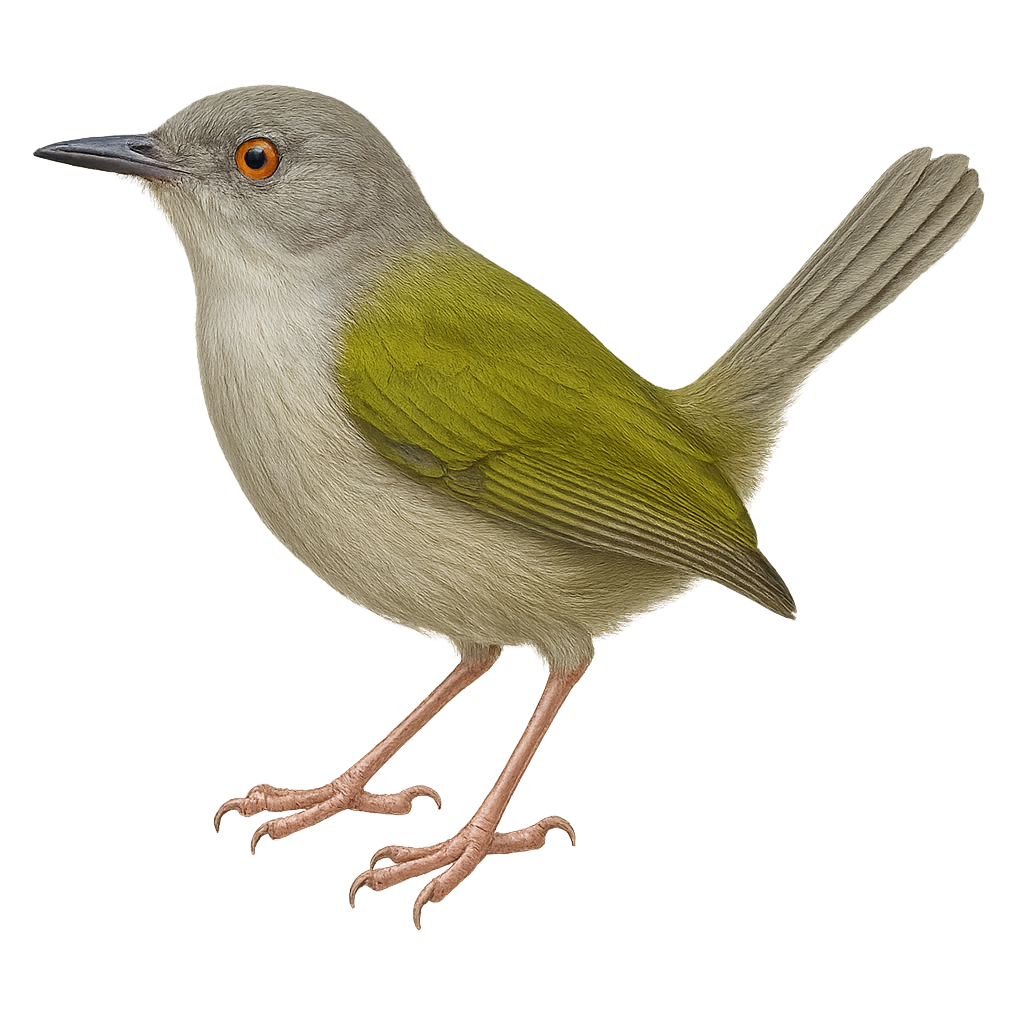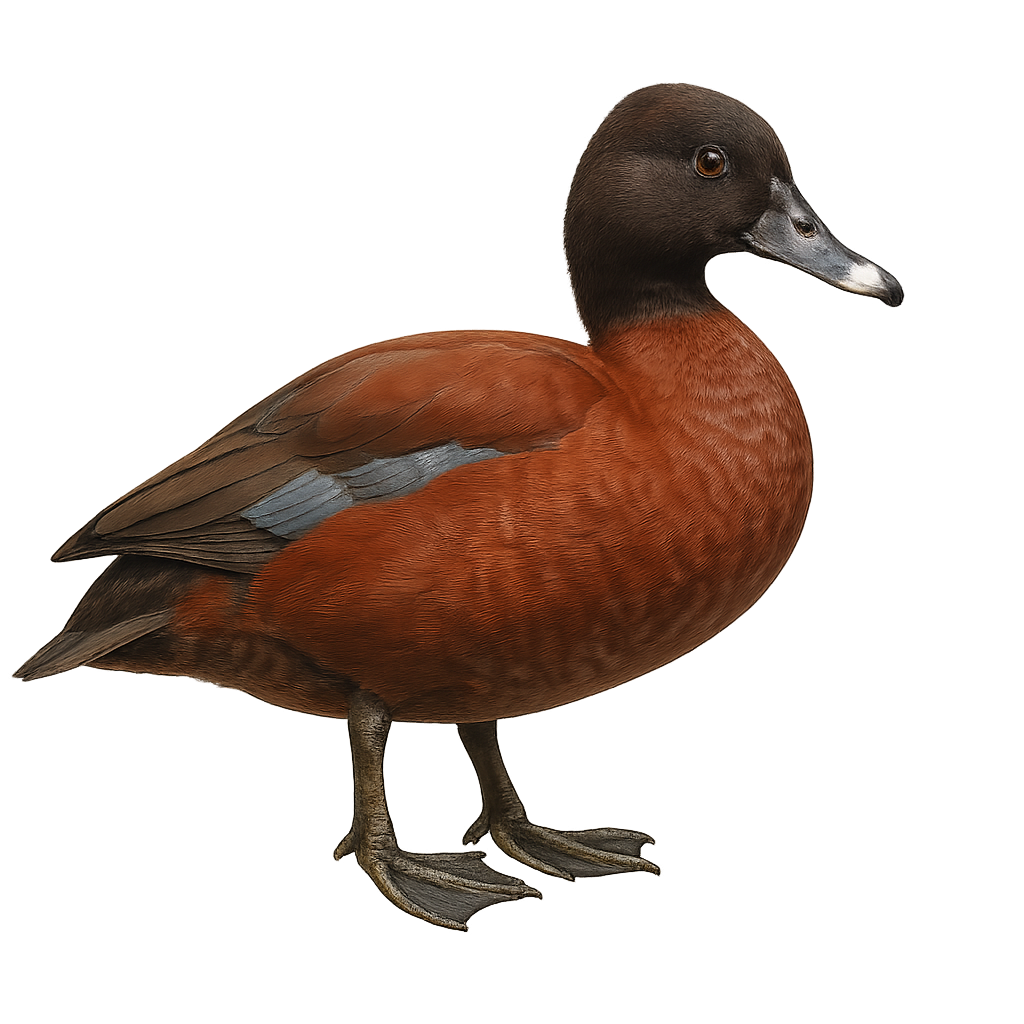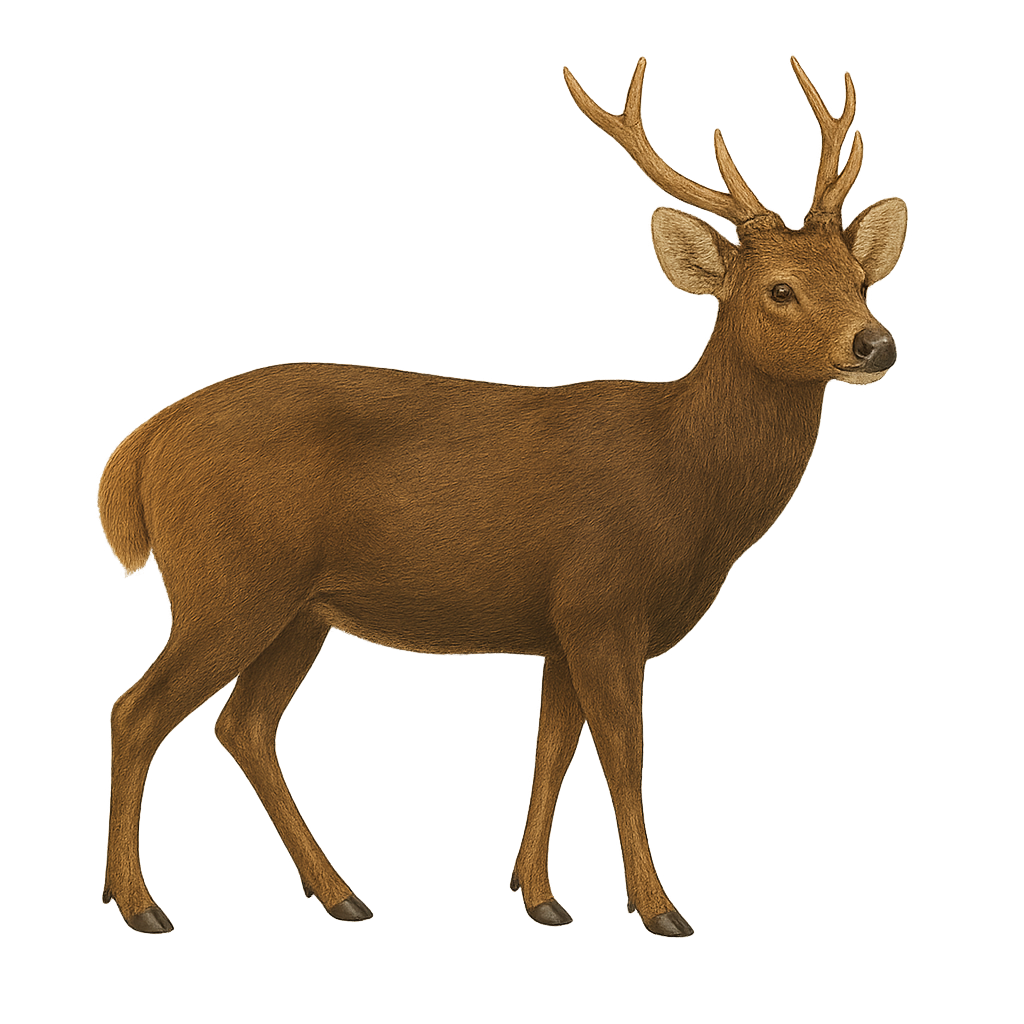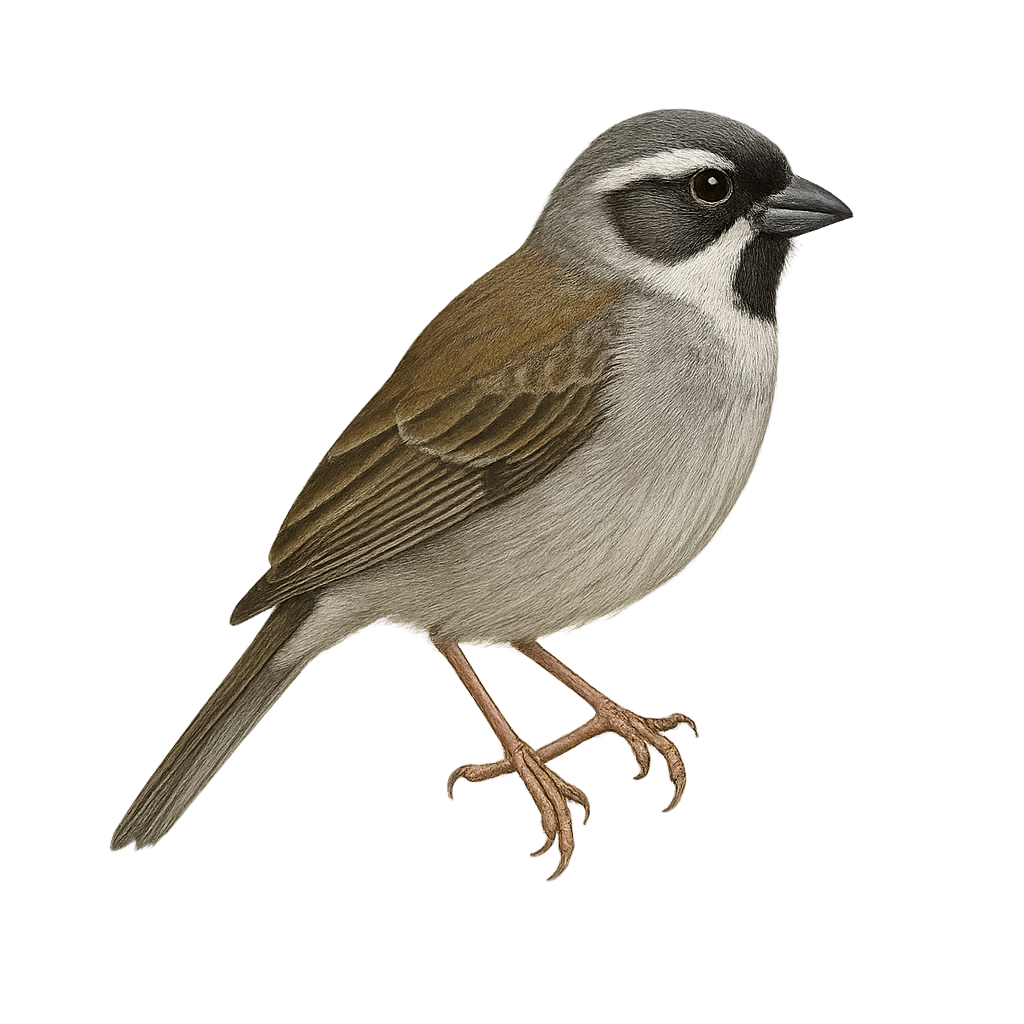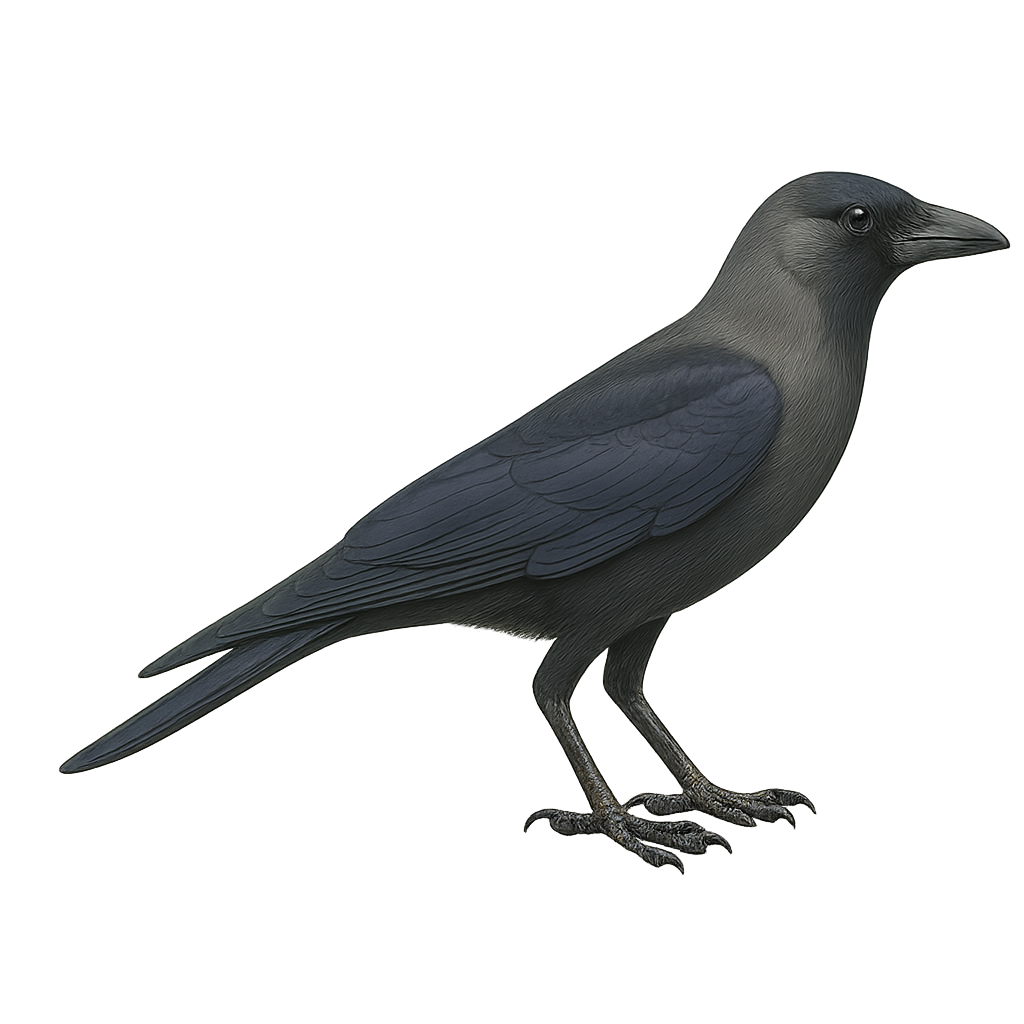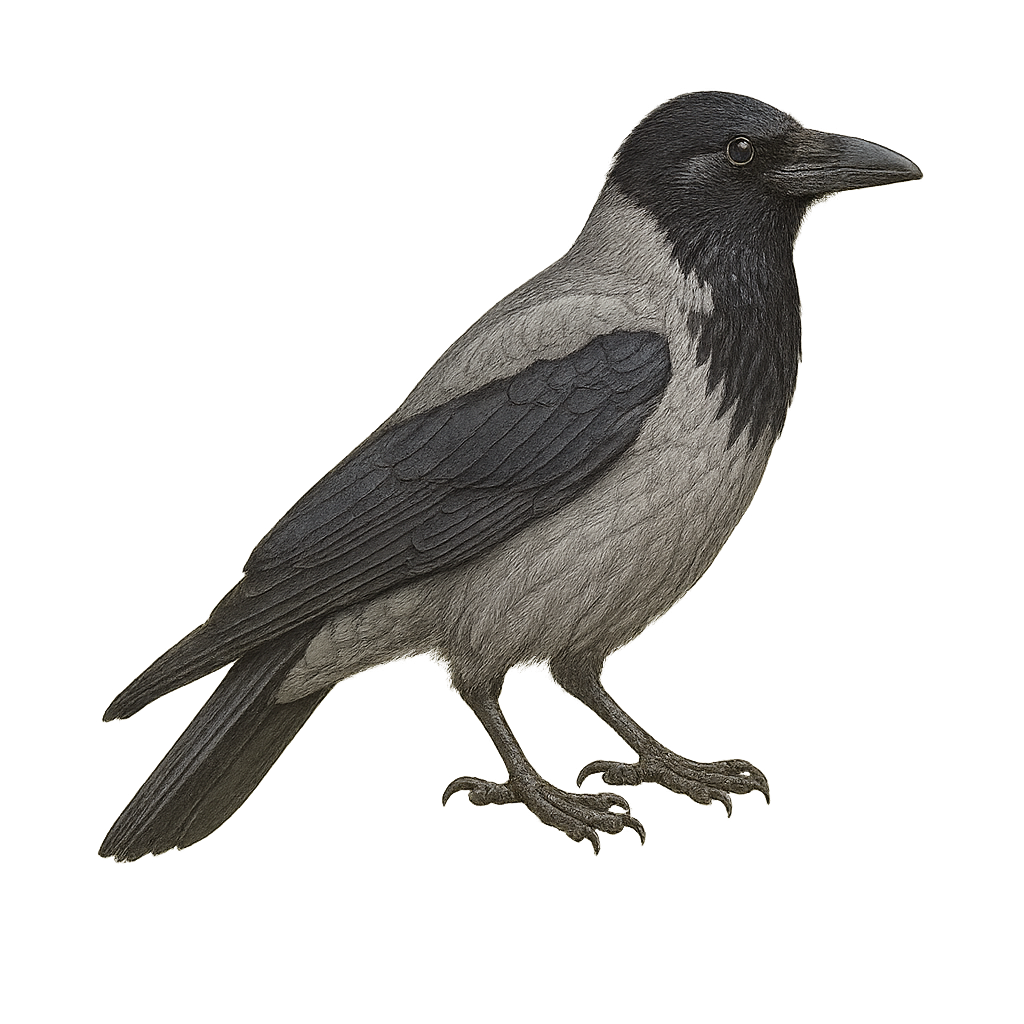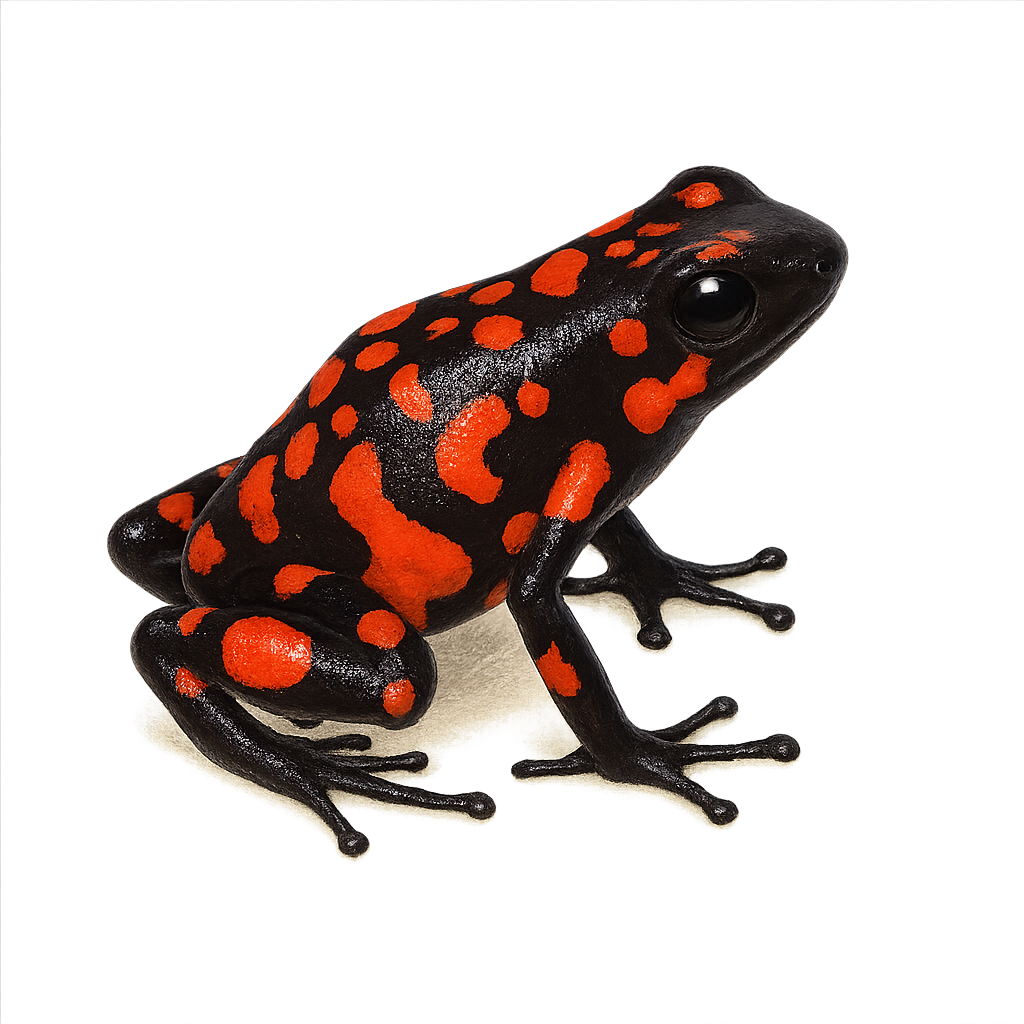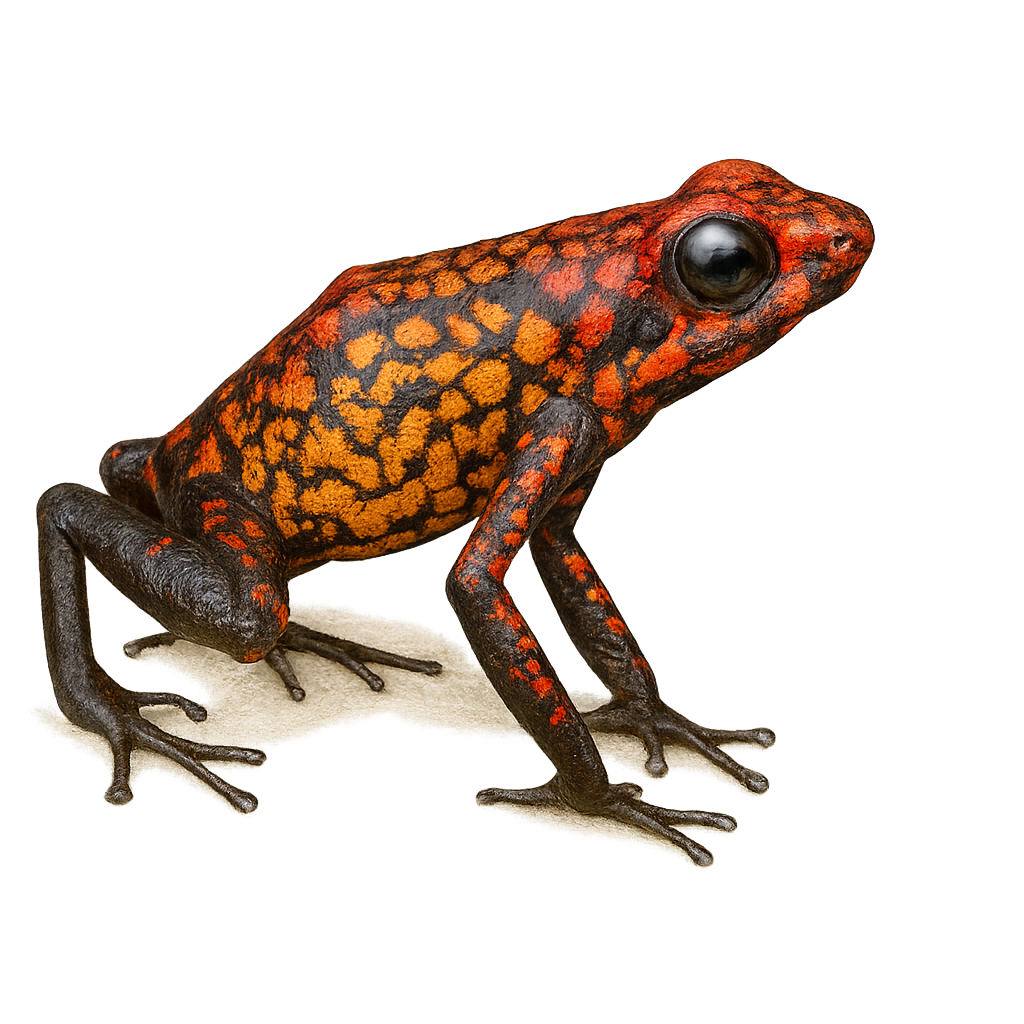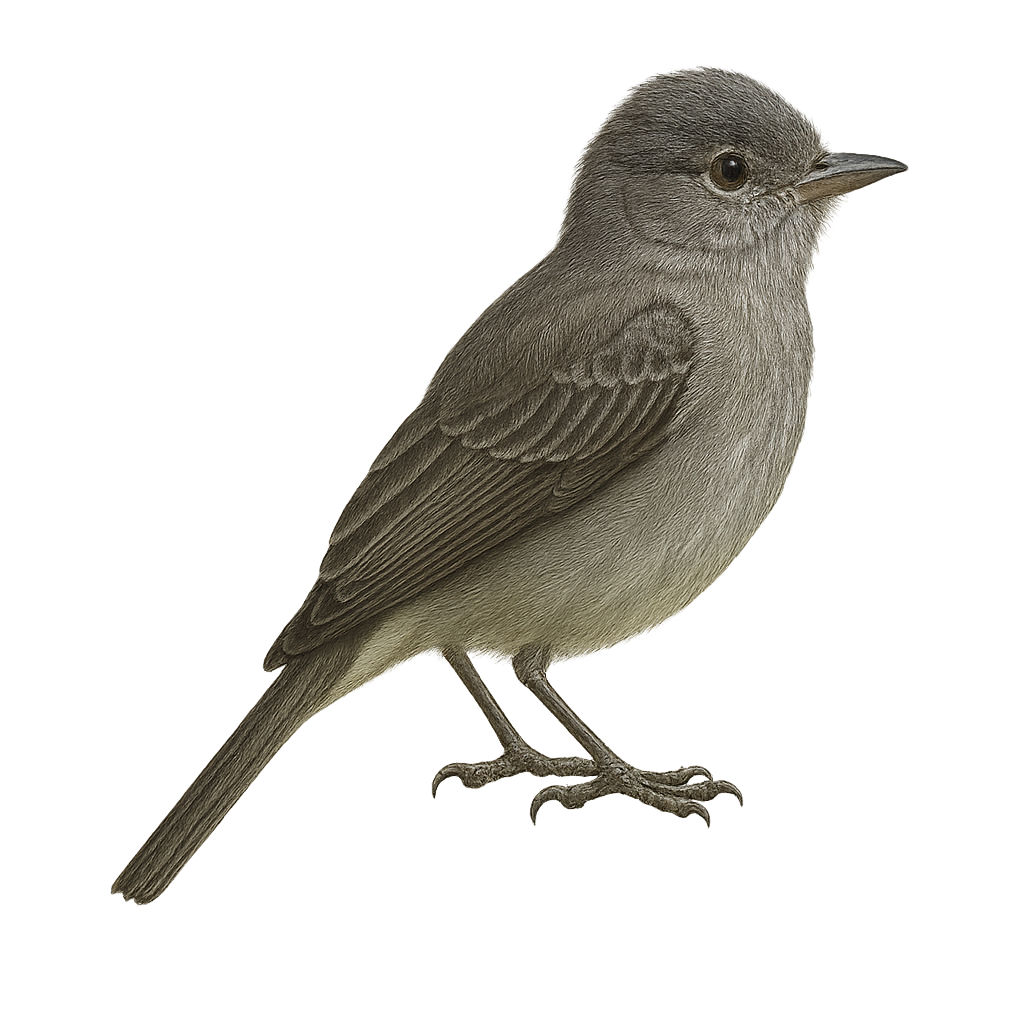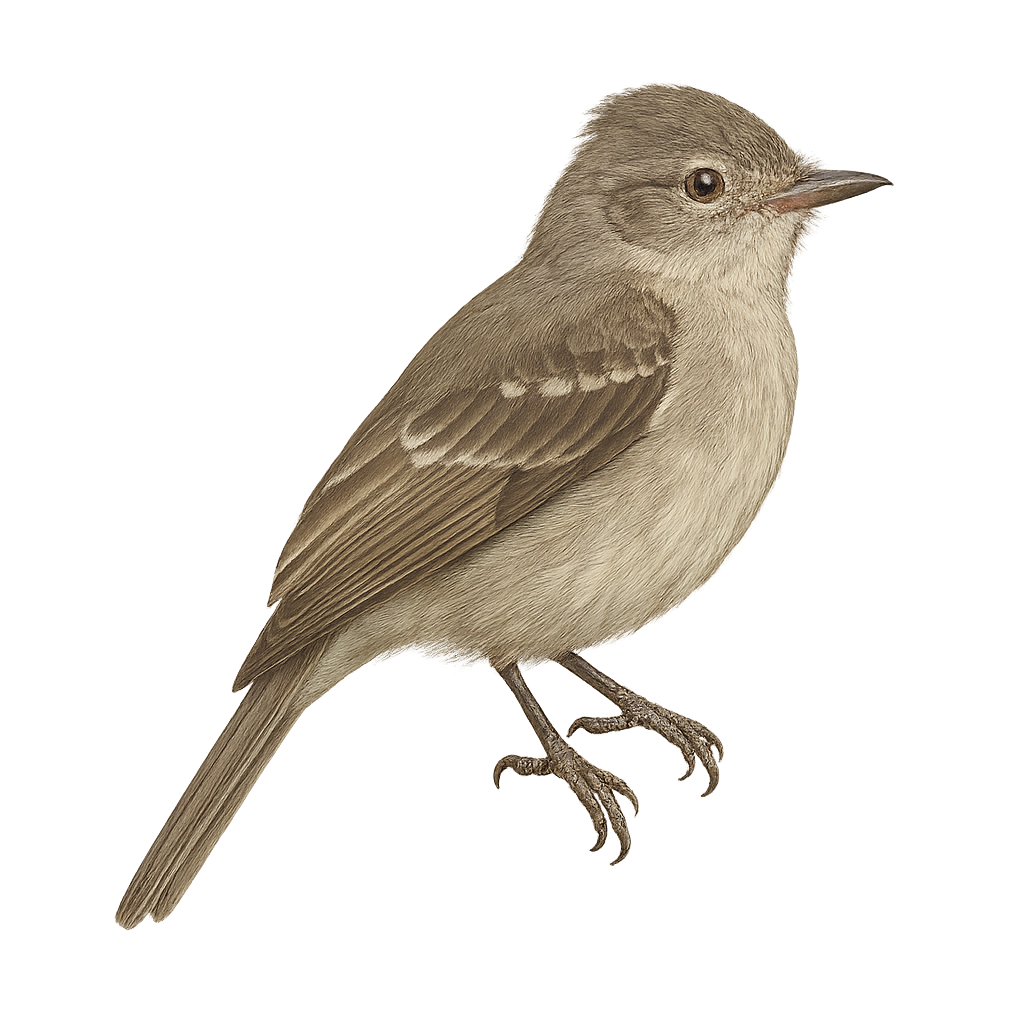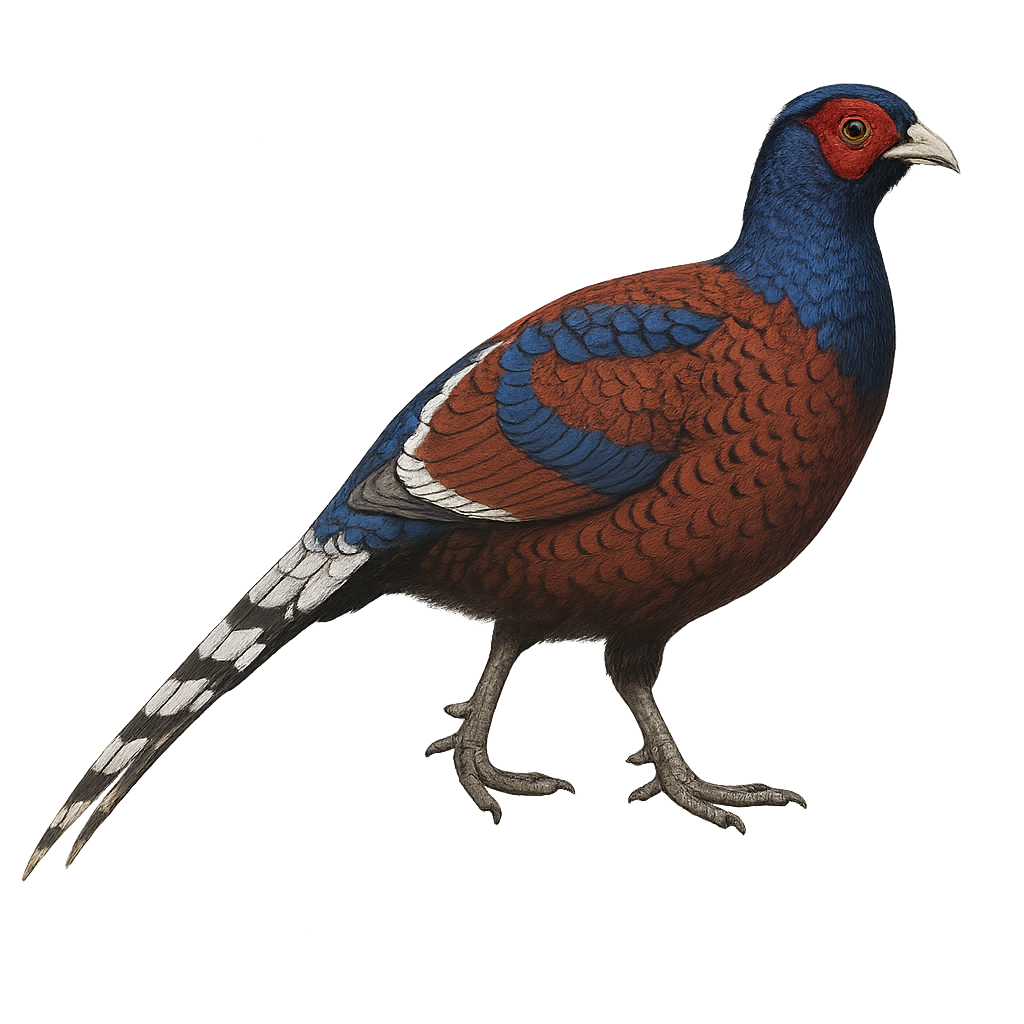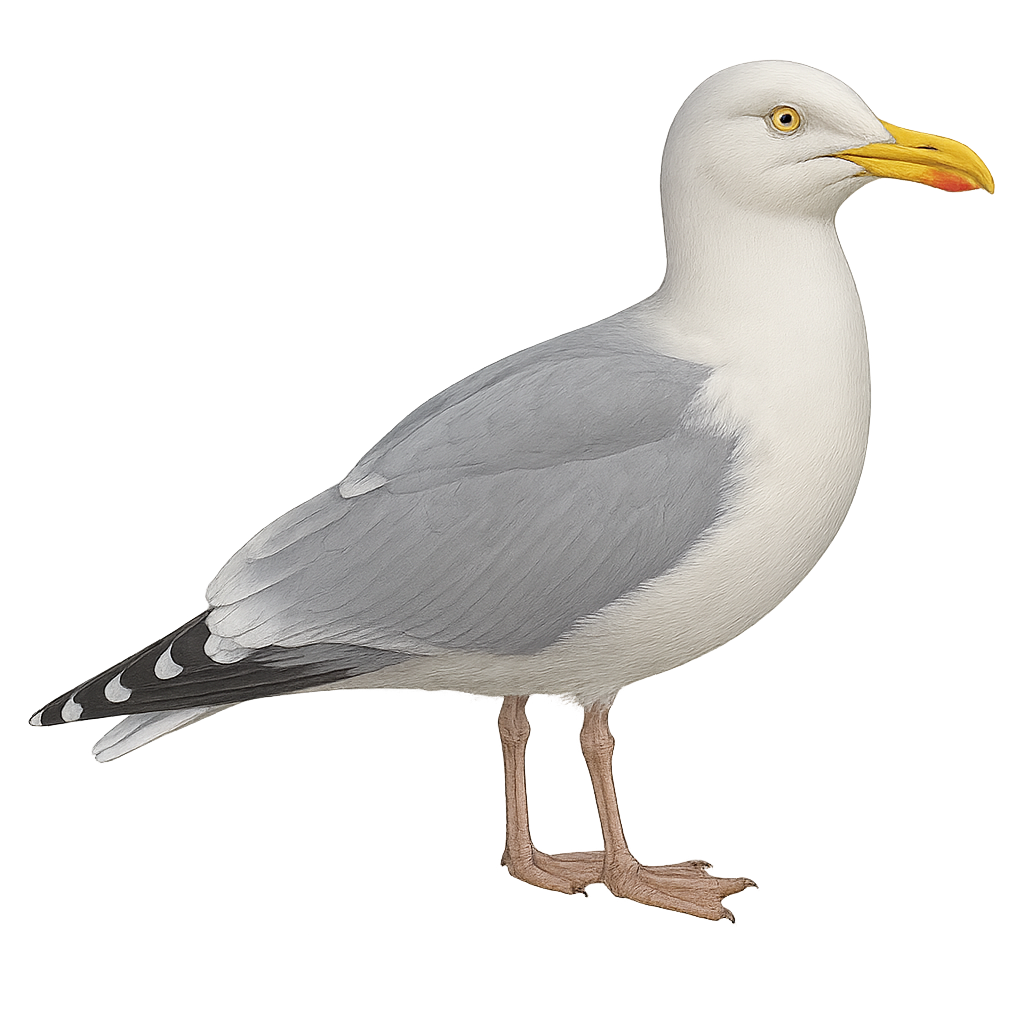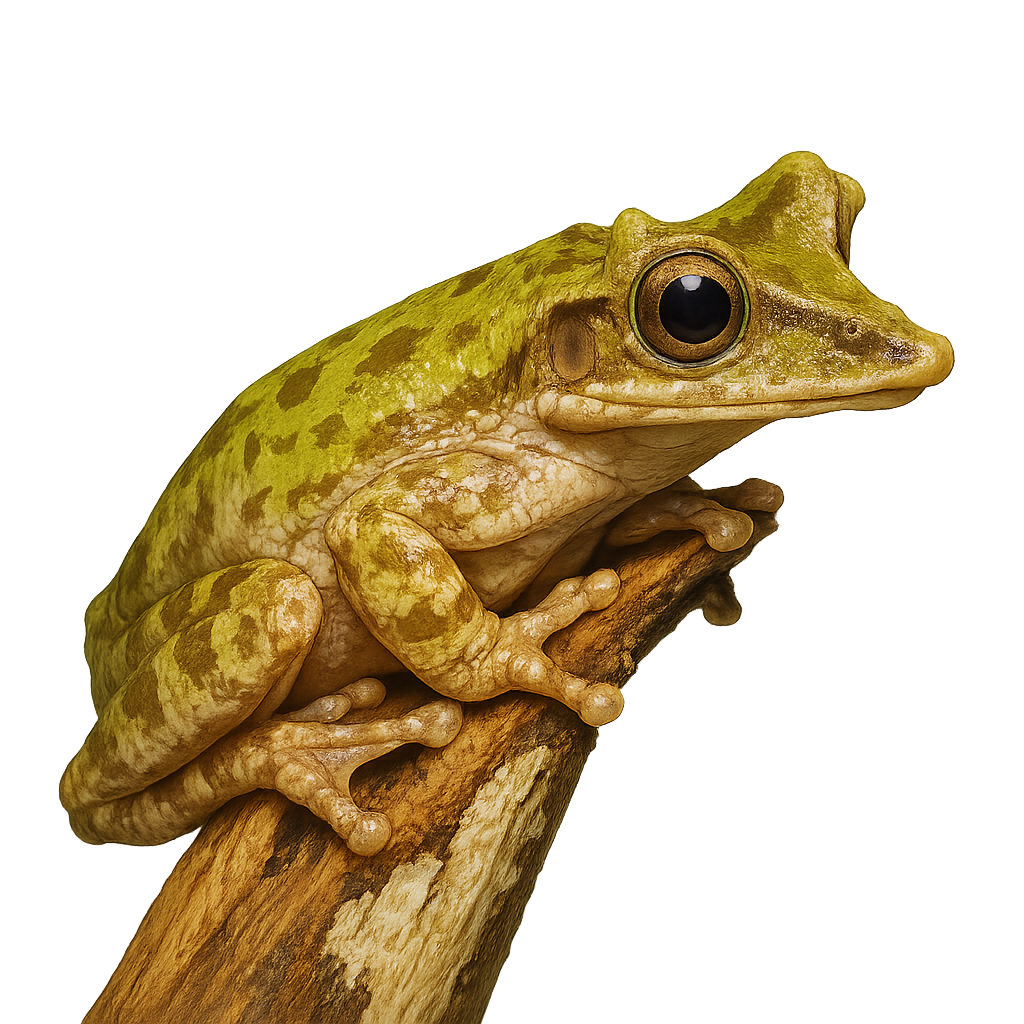The Hyacinth Macaw, or Anodorhynchus hyacinthinus, is the largest parrot in the world, reaching up to one meter in length. Its striking cobalt blue plumage and powerful beak make it a remarkable bird. Native to the tropical regions of South America, particularly Brazil, it primarily inhabits rainforests and savannas. Although sociable, it is often seen in small groups or pairs. Its diet mainly consists of palm nuts, which it easily cracks with its strong beak. Unfortunately, the species is threatened by deforestation and illegal trade, leading to a significant decline in its population.
The Harlequin Duck, Histrionicus histrionicus, is a medium-sized duck known for its striking plumage. Males display a mix of slate blue, white, and chestnut, with distinctive patterns on the head and body, while females are more subdued with brown tones and white spots around the eyes. This duck is primarily found in fast-flowing rivers and rocky coastlines of North America and Northeast Asia. It is known for its ability to dive and swim in turbulent waters in search of crustaceans and mollusks. The Harlequin Duck is a migratory bird, spending winters along the coasts and returning to rivers to breed in the spring.
The Humpback Whale is one of the most iconic whale species, known for its spectacular jumps and fascinating songs. This massive whale can grow up to 16 meters long and weigh up to 36 tons. It is found in oceans worldwide, migrating between the cold waters of the Arctic and the warmer tropical waters to breed. Humpback whales primarily feed on krill and small fish, which they capture using a group hunting technique known as "bubble netting," where they create bubbles underwater to trap their prey.
In addition to their impressive hunting behaviors, Humpback Whales are also famous for their complex songs, which males use to attract females during the breeding season.
The Hudsonian Godwit, Limosa haemastica, is a medium-sized migratory bird belonging to the family Scolopacidae. It is recognizable by its long, slightly curved bill and its brownish plumage with shades of gray and rufous. During the breeding season, males display more vibrant colors. This bird primarily inhabits wetlands, marshes, and muddy shores. Its migration is impressive, covering long distances between its breeding grounds in North America and its wintering grounds in South America. The Hudsonian Godwit feeds mainly on small invertebrates found in the mud. Although its conservation status is concerning, it remains a fascinating sight for birdwatchers.
The Honey Buzzard is a medium-sized diurnal raptor, easily recognizable by its plumage marked with light and dark brown patterns and its slender build. It primarily inhabits open forests, hedgerows, and wooded areas in Europe and Asia, and feeds mainly on larvae of bees, wasps, and small insects, which it captures by flying above beehives or attacking the nests of social insects.
This raptor uses its powerful talons and curved beak to extract larvae from the nests. The Honey Buzzard is also known for its ability to undertake long migratory flights, leaving its breeding grounds in Europe to travel to warmer regions in North Africa for the winter. While the population remains stable in many areas, the Honey Buzzard may be threatened by habitat loss and the reduction in insect populations on which it relies.
The Hooded Pitta, scientifically known as Pitta sordida, is a vibrant and captivating bird belonging to the Pittidae family. It is characterized by its striking plumage, featuring a black head, bright green body, and wings with blue and red hues. This bird is primarily terrestrial, moving nimbly through the undergrowth of Southeast Asian tropical forests. Known for its melodious song and loud calls, the Hooded Pitta feeds mainly on insects, small invertebrates, and fruits. It is often seen alone or in pairs, and its elusive nature makes it difficult to spot. Despite its beauty, it faces threats from habitat loss due to deforestation.
The House Bunting, or Emberiza sahari, is a small bird with a discreet plumage, mainly brown with shades of gray and beige. It is well adapted to arid and semi-arid environments, blending perfectly into the landscape. It is primarily found in North Africa, especially in desert and mountainous regions. Known for its melodious song, often heard at dawn, it feeds mainly on seeds but can also consume insects, especially during the breeding season. The House Bunting is a sociable bird, often seen in small groups, and is relatively not very shy, making it accessible for observation.
The Hartebeest is a medium-sized antelope, easily recognized by its slender body, long legs, and slightly curved horns. It primarily inhabits the savannas and open plains of North and West Africa, where it forms large herds. The Hartebeest feeds mainly on grasses and low vegetation, and it is particularly well adapted to life in arid and semi-arid environments.
This species is mainly active at dawn and dusk, avoiding the intense heat of the day. The Hartebeest is threatened by habitat loss due to agriculture and hunting, and although conservation efforts have been made, its population remains vulnerable. It is listed as "Near Threatened" on the IUCN Red List.
The Northern Harrier is a medium-sized raptor, easily recognizable by its gray and brown plumage, with distinct markings on its wings and a slightly rounded head. This diurnal bird primarily inhabits open areas such as grasslands, cultivated fields, and marshes, mainly in Europe and Asia. The Northern Harrier hunts small mammals, birds, and insects, which it captures by flying low, often making wide circles in search of prey.
This raptor is migratory, leaving its breeding grounds in Europe to head to North Africa during the winter. The Northern Harrier is also known for its majestic flight, which makes it easily identifiable. Although its population is declining in some areas due to habitat loss and human disturbances, conservation efforts are underway to help stabilize its populations.
The Harris's Hawk, Parabuteo unicinctus, is a medium-sized raptor known for its dark brown plumage, reddish shoulders, and white-tipped tail. It is particularly noted for its unique social behavior among raptors, often hunting in organized groups, allowing it to capture larger and faster prey. Native to the arid and semi-arid regions of the Americas, it adapts well to various environments, from deserts to mangroves. Its ability to cooperate and communicate with its peers makes it a fascinating subject of study for ornithologists. In captivity, it is often used in falconry due to its intelligence and ease of training.
The Hartlaub's Duck is a fascinating bird belonging to the Bucerotidae family. It is recognizable by its glossy black plumage and distinctive bill, often adorned with white markings. This hornbill primarily inhabits the humid tropical forests of West Africa, where it feeds on fruits, insects, and small animals. Its social behavior is interesting, as it often lives in small family groups. The calls of the Hartlaub's Duck are powerful and resonant, playing a crucial role in communication among group members. Although its habitat is threatened by deforestation, this bird is currently classified as of least concern by the IUCN.
The Hemprich's Hornbill is a fascinating bird, recognizable by its large bill and slender silhouette. It has predominantly black plumage with metallic sheen, contrasting with its white and red bill. This hornbill is often seen in pairs or small groups, moving nimbly through trees. It primarily inhabits the arid and semi-arid regions of East Africa, notably in Ethiopia, Somalia, and Kenya. Its diet is varied, consisting of fruits, insects, and small vertebrates. The Hemprich's Hornbill plays a crucial role in seed dispersal, thus contributing to forest regeneration.
The Hartert's Camaroptera is a small passerine bird belonging to the Cisticolidae family, predominantly found in sub-Saharan Africa. It is characterized by its olive-green back and pale grey underparts, with a short, often cocked tail. Known for its melodious and complex song, this bird is often heard before it is seen. It primarily inhabits dense undergrowth, secondary forests, and thickets. Its ability to blend into its surroundings makes it challenging to spot. The camaroptera is a territorial bird, often living in pairs or small family groups. It feeds mainly on insects and small invertebrates, which it captures by foraging through dense foliage.
The Hartlaub's Duck, or Pteronetta hartlaubii, is a little-known species of duck endemic to the tropical rainforests of Central Africa. This medium-sized duck has dark brown plumage with metallic sheen on its wings and a lighter head. It is often seen in small groups, moving quietly along rivers and swamps. Its preferred habitat includes dense forests and wetlands, where it feeds mainly on seeds, small invertebrates, and aquatic plants. Although generally discreet, it can be curious and approach silent observers. Habitat conservation is crucial for its survival, as deforestation poses a significant threat.
The hog deer, or Hyelaphus porcinus, is a medium-sized deer native to South and Southeast Asia. It is characterized by its stocky body and relatively short legs, giving it a robust appearance. Its coat is brown with lighter shades on the belly and underparts. Males have short, thick antlers, often used in dominance battles. This deer prefers grassland and wet forest habitats, where it primarily feeds on grasses, leaves, and fruits. Although generally solitary, the hog deer can form small groups, especially outside the rutting season. It is known for its ability to move quickly through dense vegetation, making it difficult to observe in its natural habitat.
The Hispaniolan Sparrow is a small passerine bird belonging to the Thraupidae family. It is primarily found in the mountainous regions and high-altitude forests of Hispaniola, which includes Haiti and the Dominican Republic. This bird is characterized by its brown-gray plumage with lighter shades on the belly and distinctive markings on the head. It is often seen in small groups, feeding on seeds and insects. The Hispaniolan Sparrow is a resilient bird, capable of adapting to various habitats, although it prefers wooded areas. Its population is stable, but it remains vulnerable to environmental changes and deforestation.
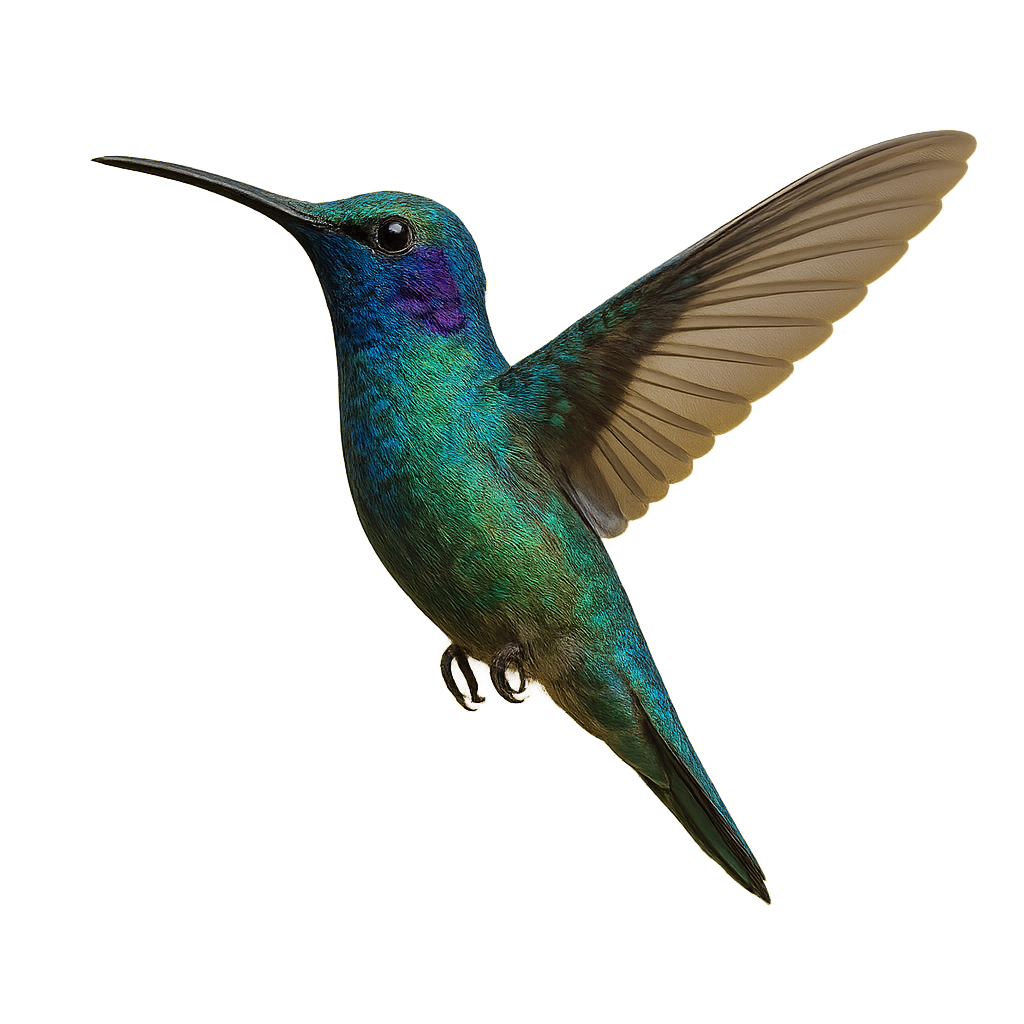
Hummingbirds, members of the Trochilidae family, are small birds exceptionally known for their ability to hover in place due to their rapid and agile wing beats. These birds are characterized by their iridescent plumage, which varies from green and blue to red and purple, depending on the species. Their small size and high energy make them easily recognizable. Hummingbirds are primarily found in tropical and subtropical regions of the Americas, from Canada to the southern parts of South America.
They primarily feed on nectar that they gather from flowers, using their long slender beak and extendable tongue to reach the food. In addition to nectar, they also consume insects and spiders for protein. Due to their high metabolism, they must feed frequently throughout the day. Hummingbirds play a key role in pollinating flowering plants, thus contributing to the biodiversity of their habitats. While their population is generally stable, some species are threatened by habitat loss and climate change.
The House Crow, Corvus splendens, is a medium-sized bird, about 40 cm long. It is recognizable by its glossy black plumage and grayish nape. Native to the Indian subcontinent, it has spread to many tropical and subtropical regions, often in connection with human activity. Opportunistic, it easily adapts to urban and rural environments, feeding on waste, insects, small animals, and fruits. Its intelligence and sociability make it a particularly interesting bird to observe. Although often considered a pest due to its impact on local species, it plays an important role in the ecosystem as a natural cleaner.
The hooded crow, Corvus cornix, is a medium-sized bird belonging to the corvid family. It is easily recognizable by its two-tone plumage, with a light gray body and black wings, head, and tail. Often seen in open landscapes, agricultural areas, and cities, it is an opportunistic feeder, consuming a wide range of foods from insects to small mammals and human waste. Highly intelligent, it is known for its problem-solving abilities. Social in nature, it often forms noisy groups. Although its call is harsh, it can mimic other sounds.
Hector's dolphin is one of the smallest dolphin species in the world, with an average size of 1.2 to 1.5 meters. It primarily inhabits shallow coastal waters of New Zealand, where it feeds on fish and squid. This dolphin is recognizable by its small, compact body, rounded fins, and distinctive face. Threatened by pollution, bycatch, and habitat loss, it is classified as endangered.
The Harlequin Poison Frog is a small, brightly colored frog native to the humid tropical forests of Colombia. Known for its vivid and varied colors, ranging from red to yellow, blue, and black, it uses these as a warning to predators of its toxicity. This species typically measures between 2 and 4 cm in length. It primarily feeds on small insects and arthropods. The Harlequin Poison Frog is diurnal, spending most of its time foraging on the forest floor. Its skin secretes toxic alkaloids, which local populations have historically used to poison hunting darts. This species is threatened by habitat loss and the illegal exotic pet trade.
The Hidden poison frog, Oophaga occultator, is a fascinating species from the Dendrobatidae family, known for its bright colors and discreet behavior. It primarily inhabits the humid tropical forests of Colombia, often hiding among leaf litter and mosses. This small frog typically measures between 2 and 3 centimeters. It is distinguished by its ability to produce powerful skin toxins, used as a defense mechanism against predators. Due to its limited habitat and increasing deforestation, it is considered vulnerable. Its reproduction is complex, involving parental care where adults transport tadpoles to secure aquatic sites.
The Highland Elaenia is a small passerine bird belonging to the Tyrannidae family. It is primarily found in the mountainous regions of South America, particularly in Colombia, Venezuela, and Ecuador. Its plumage is generally dull, with shades of gray and brown, allowing it to blend into its natural environment. This bird is often identified by its distinctive song, a melodious whistle that echoes through cloud forests and wooded areas. Although discreet, the Highland Elaenia plays a crucial role in the ecosystem by aiding in seed dispersal and insect population control.
The Highland Elaenia is a small passerine bird belonging to the Tyrannidae family. It is characterized by its subtle plumage, mainly olive-gray, with lighter shades on the belly. Its often-raised crest and slightly streaked wings add to its discreet charm. Found primarily in the humid forests and wooded areas of South America, it feeds on insects and fruits. Although often difficult to spot due to its discreet behavior, its melodious song reveals its presence. The Highland Elaenia is a resilient bird, capable of adapting to various habitats, but it remains vulnerable to deforestation and the loss of its natural habitat.
The Helmet Vanga, Euryceros prevostii, is an endemic bird of Madagascar, known for its distinctive casque-shaped bill. This large, curved bill is essential for feeding, primarily on insects and small invertebrates found in the island's humid tropical forests. Its plumage is mainly blue-black with metallic sheen, and it features white markings on the wings. The Helmet Vanga is a social bird, often seen in small groups. It plays a crucial role in the ecosystem by helping control insect populations. Unfortunately, deforestation threatens its natural habitat, making it a vulnerable species.
The Hume's Pheasant, or Syrmaticus humiae, is an elegant and rare bird native to the mountainous forests of Southeast Asia, particularly in Myanmar, China, and India. This pheasant is distinguished by its striking plumage, featuring shades of brown, blue, and white, and a characteristic long tail. Males display more vibrant colors than females, who are more subdued. They primarily inhabit oak and pine forests, where they feed on seeds, fruits, and insects. The Hume's Pheasant is a shy and discreet species, often difficult to spot in its natural habitat. Its population is threatened by deforestation and hunting, making it a protected species.
The herring gull is a large seabird in the family Laridae, up to 66 cm long with a wingspan of up to 1.4 m. It has a white head, body and tail, grey back and wings with black wingtips marked with white spots, and pink legs. It breeds in coastal colonies on islands, cliffs and urban roofs, foraging on fish, crustaceans, invertebrates and human refuse. The breeding season runs from April to June, when it lays 2–3 eggs in a simple ground scrape.
The Horned Grebe, or Podiceps auritus, is a medium-sized waterbird known for its striking breeding plumage. During the breeding season, it displays a black head with golden feather tufts resembling horns, a dark back, and a white belly. Outside the breeding season, its plumage becomes duller, with gray and white tones. This grebe is an excellent swimmer and diver, feeding mainly on small fish, aquatic insects, and crustaceans. It inhabits freshwater lakes and ponds, often surrounded by dense vegetation. Although its population is stable in some areas, it is declining in others, primarily due to habitat loss and pollution.
The Helmeted Tree Frog is a fascinating amphibian species, known for the distinctive helmet-like protuberance on its head. This protuberance, resembling a helmet, helps it camouflage among the leaves and branches of trees in the humid tropical forests. It is mainly found in the forests of Costa Rica, Panama, and Nicaragua. It is nocturnal and terrestrial, spending much of its time in the canopy near streams where it lays its eggs. This frog is rather discreet and often hides in dense vegetation to avoid predators.
The Hodgson's Treecreeper, or Certhia himalayana, is a small, elusive bird found in the coniferous forests of the Himalayas. It is characterized by its brown, speckled plumage that allows it to blend seamlessly with tree bark. Its slender body and thin, curved beak are perfectly adapted for its arboreal lifestyle. It primarily feeds on insects, which it extracts from crevices in tree trunks. This bird is often seen spiraling up trees, using its stiff tail as support. Although not very shy, it is difficult to spot due to its camouflage. Its song is a high-pitched trill, often heard before the bird is seen.



